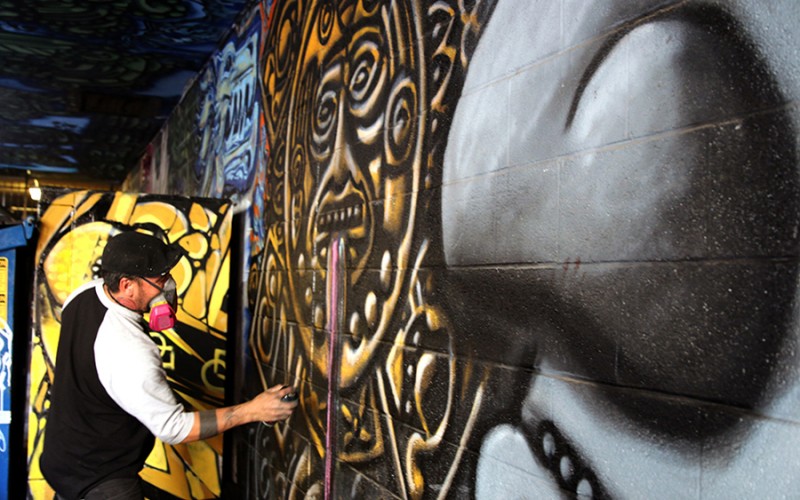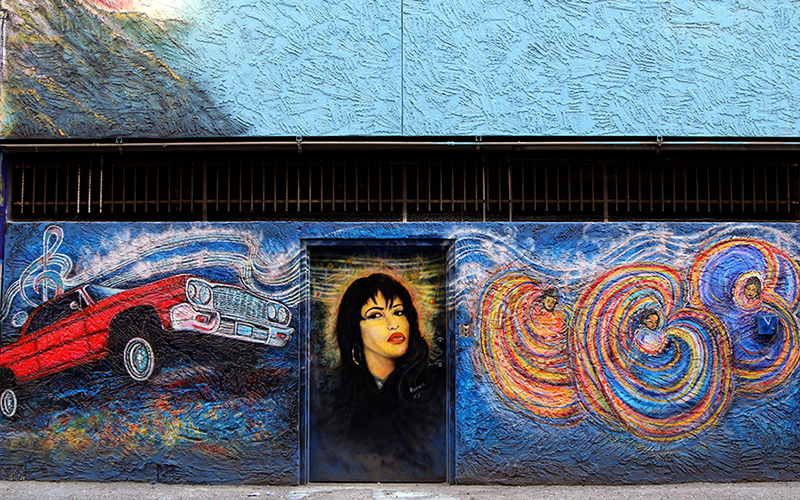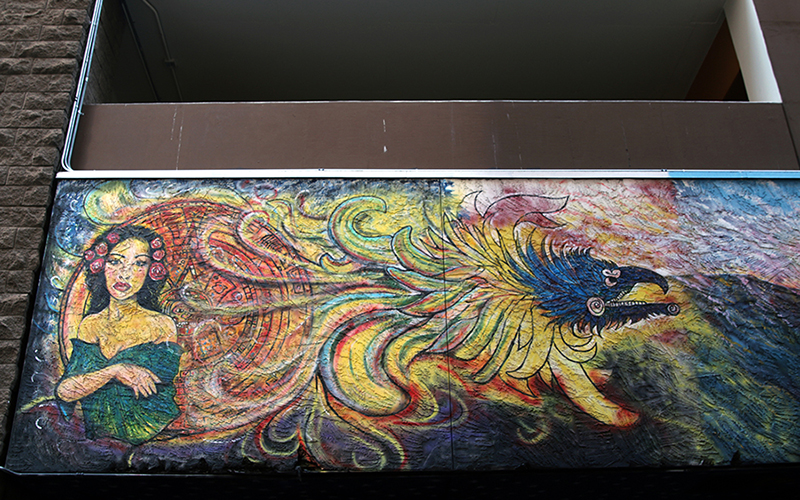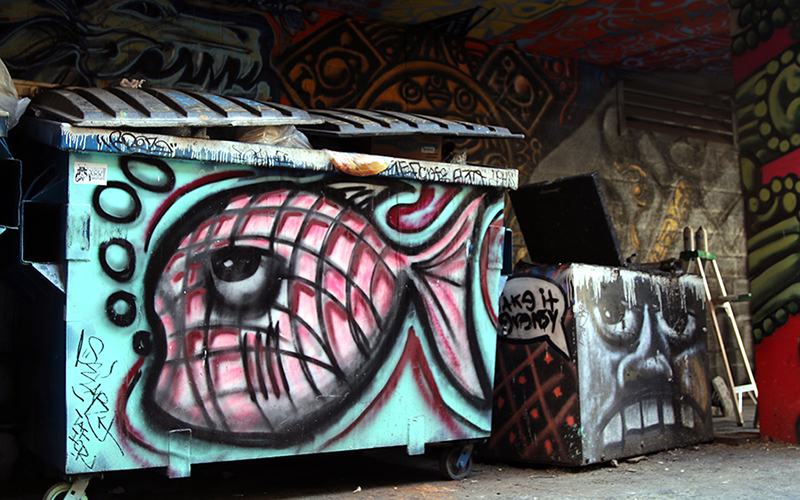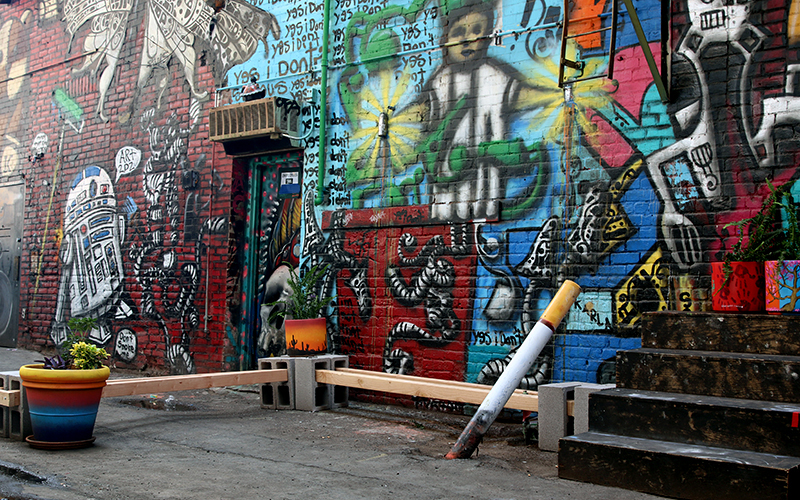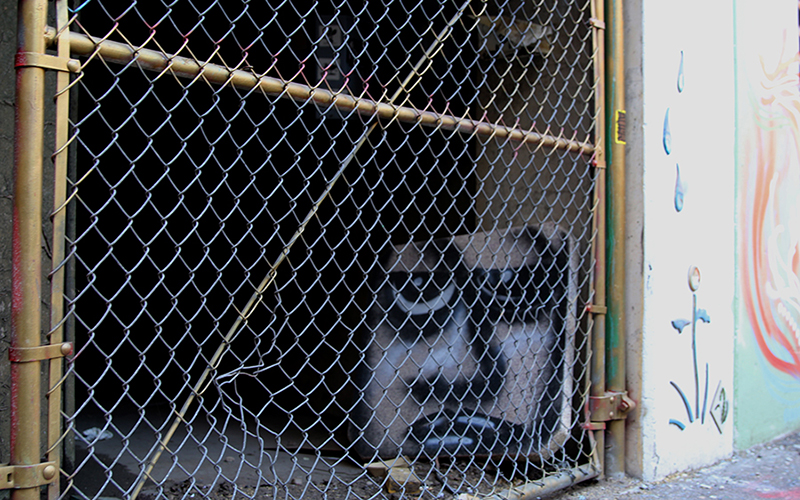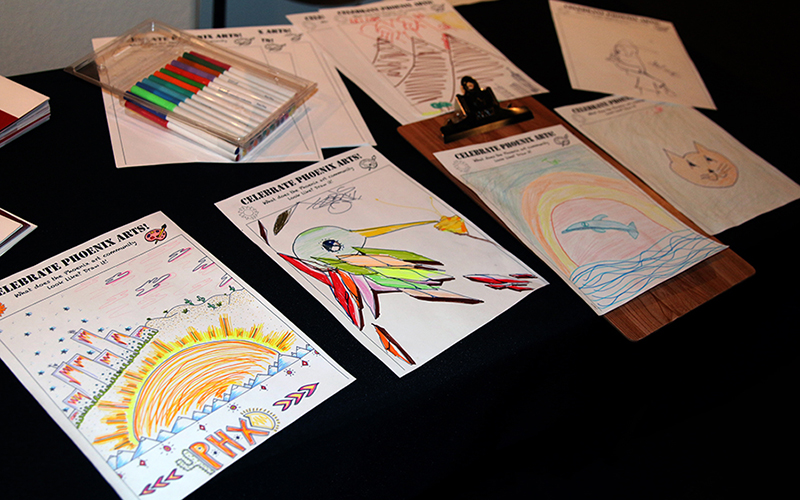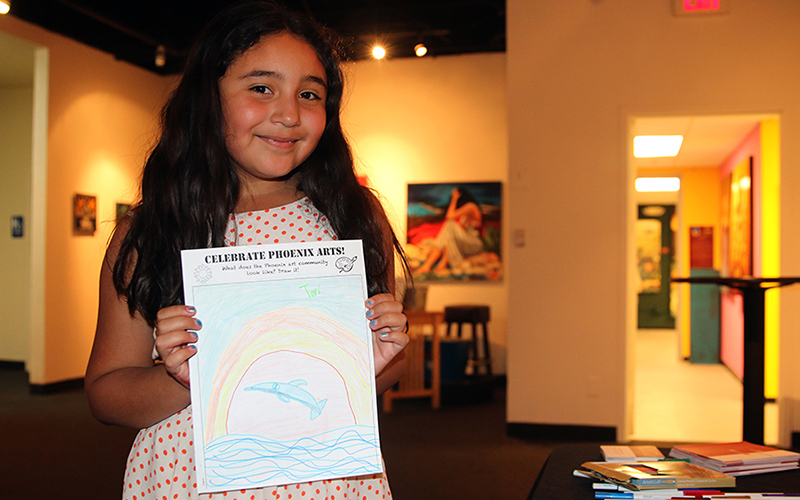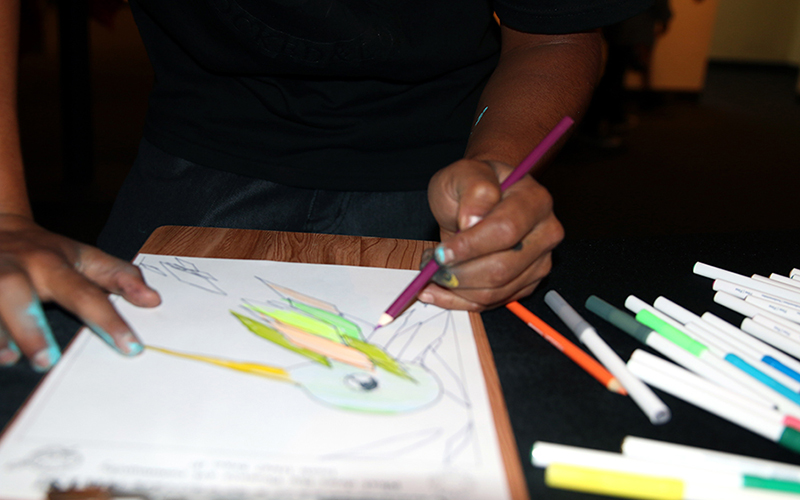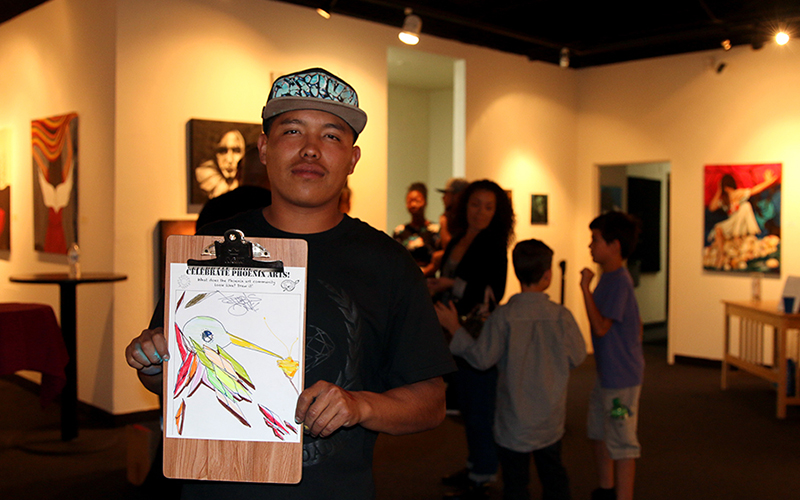PHOENIX – Scattered across the Valley are vibrant, visual homages to a rich past, present and future. Latino, Hispanic and Chicano art has had an iconic presence in the Southwest for hundreds of years, and nowhere is this presence more striking than in downtown Phoenix. Though Latino artists of all ages in Phoenix share this rich history, their art reflects it in distinct ways.
While walking the streets in the area, it doesn’t take long to notice differences rooted in generation, perspective and identity.
“The fine art is like classical music,” photographer Johnny Lozoya said. “And the street art is like punk rock.”
The Arizona Latino Arts and Cultural Center’s Galeria 147 sits right in the core of downtown Phoenix. Its proximity to the Phoenix Convention Center draws visitors from around the world and gives them a generous taste of southwestern art.
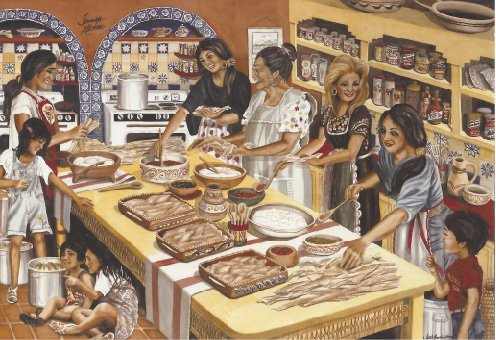
This piece by Girón called “La Tamalada” depicts a kitchen full of mothers, grandmothers, aunts and children making tamales. This piece is on display at the Arizona Latino Arts and Cultural Center’s Galeria 147. (Photo courtesy José Andrés Girón)
The walls at the center are covered in original paintings by Valley artists, depicting everything from a warm family dinner to iconic Latino figures like Cesar Chavez.
“The Latino art community is very important to the area, because we’re a good percent of the population,” artist and gallery curator José Andrés Girón said. “We want to project the positive view of Hispanics and Latinos. We want to share our rich culture, because it not only helps the Latino community, but it also helps the community at large.”
On a slow weekday afternoon at the gallery, photographer and gallery volunteer Johnny Lozoya described the importance of Latino history in Phoenix and fondly reminisced about an event last year where Azteca dancers performed in the streets in front of the Convention Center.
“The last time that happened on this very spot was thousands of years ago,” he said.
Hanging behind Lozoya as he spoke was a large painting depicting this collision of cultures, capturing colorful Azteca dancers twirling in front of the downtown Phoenix skyline.
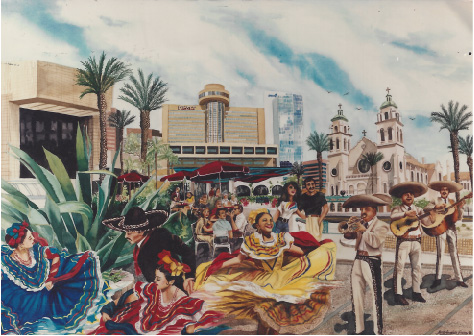
Girón painted this piece to signify cultures and times colliding, all in the core of the city he calls home. This piece can be viewed at the Arizona Latino Arts and Cultural Center’s Galeria 147. (Photo courtesy José Andrés Girón)
Artist like Lozoya and Girón take pride in their history and culture, and this pride shines through in their art. Many of Girón’s paintings use traditional Latino styles and imagery, from a family making tamales to colorful street fiestas. Girón says this style of art is important to both the region and the world, as it represents immense history, culture and traditions that are unique to this area and valuable to all humans.
A fresh coat of culture
Just blocks away from Galeria 147, many buildings are plastered with another form of cultural expression. Intricate murals by artists like Thomas “Breeze” Marcus, Lalo Cota and Angel Diaz adorn walls and alleys across downtown Phoenix.
Many of these murals embody a fresh take on Latino culture. Bright colors, funky low riders and edgy Dia de los Muertos skulls meet the eyes of passersby. A new generation of Latino talent has taken to the streets to find homes for their art.
Carlos Rivas, 36, considers himself first and foremost a street artist.
“It’s my favorite form of art,” Rivas said. “I think in some ways it’s the last freedom art has. I’m painting buildings, they call it tagging, but really I’m giving you this image for free. You don’t have to go to an event or go into a gallery and decide if you want the art or not, it’s just there, and that’s powerful.”

A portion of the mural in the alley behind the Arizona Latino Arts and Cultural Center completed by Carlos Rivas. (Photo by Lindsay Robinson/Cronkite News)
While working with the Arizona Latino Arts and Cultural Center, Rivas has learned to better value his art and refined his techniques, but he holds on to his bold style and love for street art. He feels a strong connection to his culture and heritage, but he struggles with the idea of art labeled as “Latino.”
“This should be a show about art, not just Latino art,” he said. “Art is art. You shouldn’t put labels in front of something so beautiful.”
Rivas and other artists like him are determined to leave a new mark for their generation.
“Just because you were passed down something, it doesn’t mean it’s wrong, but it doesn’t mean that’s the only way you can do something,” Rivas said. “What era is this going to be? The era of the repeaters? What do you have to say? What are you going to add to this world?”
Rivas said Latino imagery is not his primary focus, but he appreciates these elements in other artists’ work. He says that he feels a deep connection to these roots, but he does not let that guide his own art. As he points to a painting in the gallery of two women smiling and making tortillas, this connection is clear.
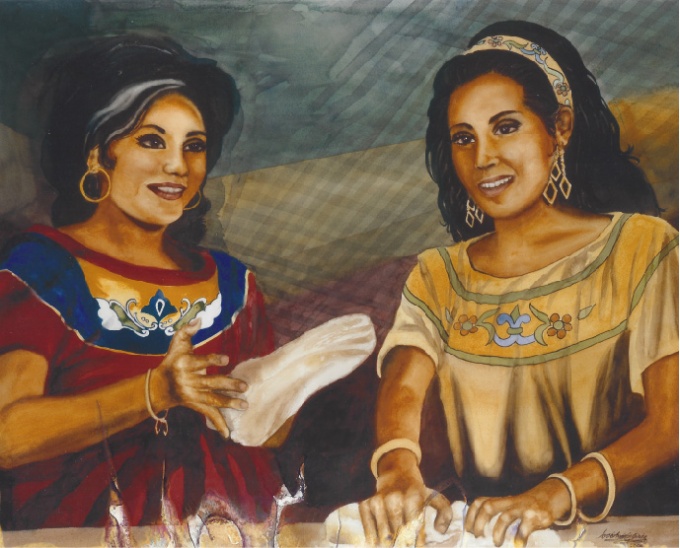
Two women smile and make tortillas in this warm portrait by Girón. This piece can be viewed at the Arizona Latino Arts and Cultural Center’s Galeria 147. (Photo courtesy José Andrés Girón)
“That’s my mom, that’s my aunts. It’s beautiful. You’re touching the soul with that,” he said. “But when the older artists see our stuff, because it’s new, because we’re stepping out of the box, sometimes they just don’t understand that. It can be frustrating and discouraging.”
Artists like Ivan Garcia, 22, have a similar perspective.
Garcia considers himself a graffiti artist originally. He says that he used to only paint or tag illegally on the streets, but he started painting murals and refining his work after becoming involved in an organization called Cyphers a few years ago.
“Murals usually have meaning, and a lot of people might not see the meaning on the graffiti aspect of it, but there is really a meaning there,” he said. “It’s a totally different world. People like murals, they don’t like graffiti.”

Street artist Ivan Garcia, 22, works on a portion of the mural behind the Arizona Latino Arts and Cultural Center. (Photo by Lindsay Robinson/Cronkite News)
Garcia says that his generation’s artists are less influenced by their history and more interested in creating something new.
“There’s a lot of meaning in that traditional art, like freedom, and all of those artists have their own way of thinking,” Garcia said. “Now the way we think, it’s like they already did their part, now let us do our part and create our own way.”
Passing down a colorful culture
Rivas painted almost exclusively on the streets until he got involved with the Arizona Latino Arts and Cultural Center. He says that the mentorship, guidance and relationships he has gained there have been better for his career than art school could have been.
“By being a curator at ALAC as well as an artist here, I get to meet all of these guys, and I mentor some more than others,” Girón said. “Those who come get more inspired, and heck I get inspired by them too.”
Girón said it is up to the older generations of Latino artists to educate and inspire young creatives.
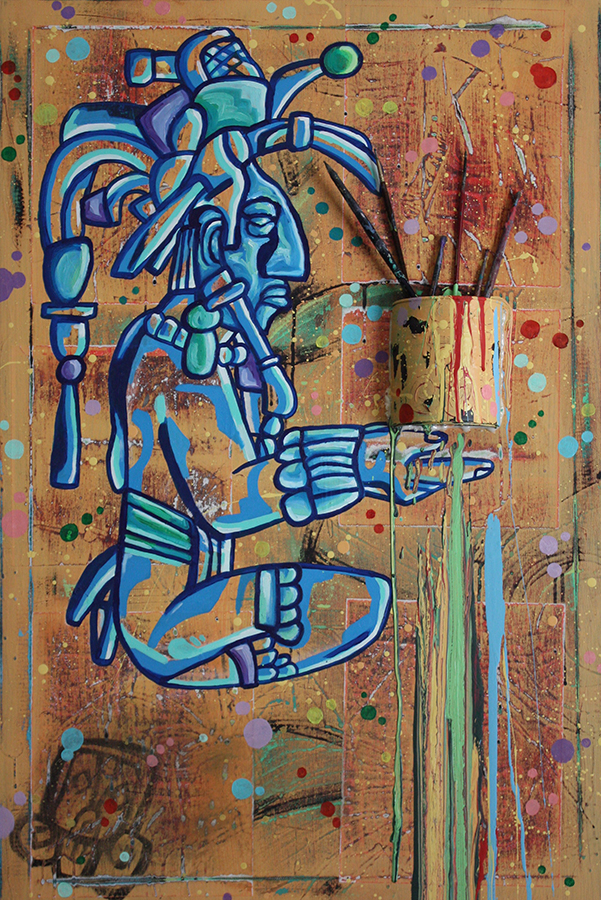
This piece by Edgar Fernandez, titled “This is my Offering,” includes features and styles that draw heavily from his Mayan roots. (Photo by Lindsay Robinson/Cronkite News)
“It’s up to us to create opportunities for them to learn and connect with their past and their history,” he said. “We can do it through our art and try to influence them to do the same. But it’s places like this that give them that opportunity.”
While some young artists may not be as influenced by this history, others like Edgar Fernandez, 25, fully embrace it. Fernandez’s parents were born in Mexico, and his Chicano roots are evident in much of his work.
“I carry Mayan descendent roots within me, and I started learning this when I first started digging into art work,” he said. “I had this inner feeling of doing cultural indigenous artwork, and I didn’t know why. But I started doing it and finding out little by little that I had Mayan roots.”
Fernandez teaches art at a high school, and he says his goal is to inspire young artists to embrace and express their culture and identity.
“A lot of stuff has been washed down from our culture,” he said. “We come from such a rich and beautiful culture, they had such an advanced civilization and their artwork is so beautiful. I think that a lot of the youth is not connected to that, so they need older artists and artists like myself to go into the schools and give workshops, mentoring and inspiration.”
Generations collaborate, celebrate and create
ALAC has launched a project to revitalize the alley behind Galeria 147. A vibrant mural depicts an array of imagery, symbolism and styles. Artists of all ages — including Rivas, Garcia, Fernandez, Girón and many more — have collaborated on the mural.
“Once all of these artists put up a beautiful mural with a message of history and a message of the present moment, it makes you go in there and feel comfortable,” Fernandez said. “I think it’s like a seed, you plant it and it’s flourishing to create beauty around the downtown area.”
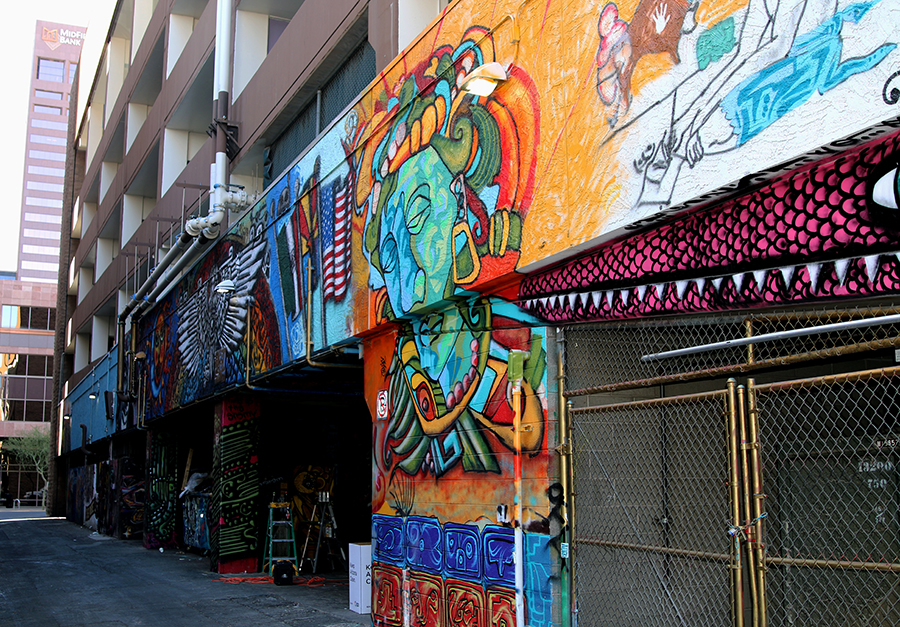
Various artists are bringing new life to the alley behind Arizona Latino Arts and Cultural Center. The mural and alley activation project will be completed by the end of April. (Photo by Lindsay Robinson)
Girón hopes the alley can be an example and inspiration for similar projects downtown.
“Latino art in Phoenix is going to grow, it has to grow,” Girón said. “Phoenix is getting bigger and bigger, there are more spaces coming up that need decorating, and there’s no shortage of upcoming Latino artists, they just need outlets to display their work.”
Valley artists give alley new life
Over the past year, various artists have collaborated to create a mural and clean up the alley behind the Arizona Latino Arts and Cultural Center. The photos below highlight their work. (Photos by Lindsay Robinson/Cronkite News)
Arts community comes together to support mural project
People involved in the Phoenix art community gathered on April 3 for a fundraising event to help support the mural activation project. The Cronkite PIN Bureau asked participants to color images that represent the Phoenix art community. Pictured below are participants who shared their drawings. (Photos by Lindsay Robinson/Cronkite News)
EDITOR’S NOTE: Sources in the Public Insight Network informed the reporting in this story through a partnership with the Cronkite PIN Bureau. To send us a story idea or learn more, click here.
